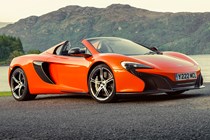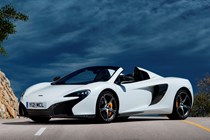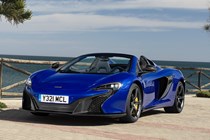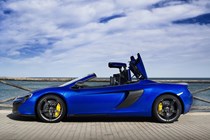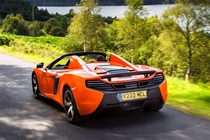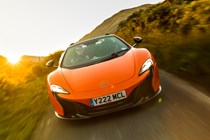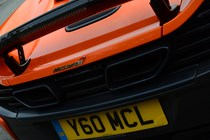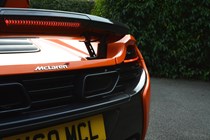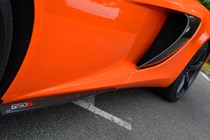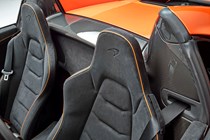McLaren 650S Spider Convertible (2014-2016) engines, drive and performance
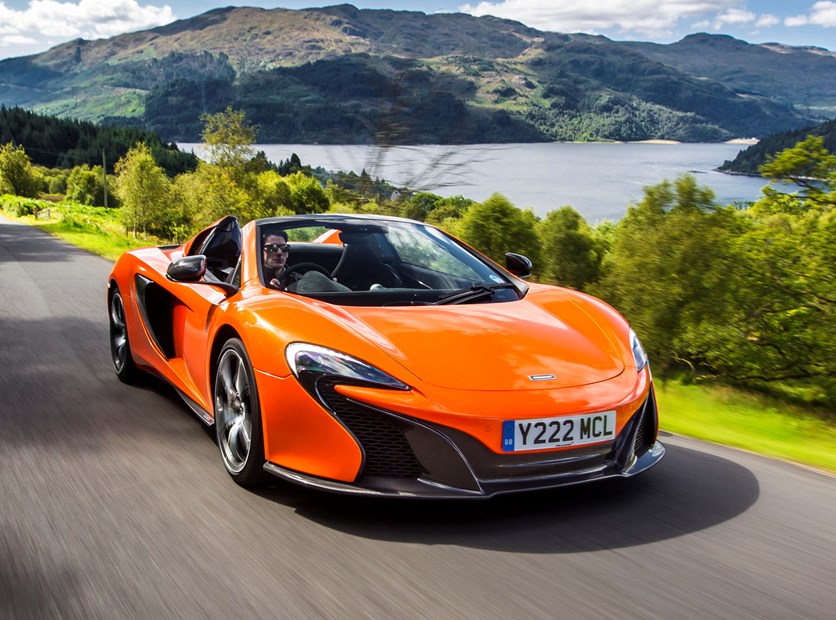
- Twin turbocharged 3.8-litre V8 produces 650hp
- Relentless acceleration into three-figure speeds
- Dispatch 0-62mph in a mere three seconds
You could accuse some supercars of subtlety, but not the McLaren 650S Spider. This is an angular, aggressive – and in the case of our test car, bright orange – speed machine that lays its cards out on the table before you’ve even pressed the starter button.
Petrol engine
Let’s get the numbers out of the way first because they only tell half the story: 3.8-litres, 650hp, 678Nm of torque and 0-62mph in three seconds flat – the same as the coupe. The McLaren 650S Spider is devastatingly quick, piling on huge speed at a rate your brain will struggle to comprehend. Keep the throttle pinned on a race track and you’ll see 124mph in 8.6 seconds and a top speed of 204mph.
The engine, nestled low down and aft of the cockpit, is the same basic unit used throughout the McLaren range, although the 650S Spider features different pistons, cylinder heads exhaust valves cam timing to boost power levels.
The manufacturer claims it designed the 650S with the relentless, instantaneous power of its hybrid P1 in mind. As a result there’s less of a power spike in the middle of the rev range than you get in a 570S and you have to look hard in high gears to find any turbo lag.
It helps that the seven-speed dual-clutch automatic gearbox is equally responsive – it seems to know exactly what ratio you need when you need it, making the single-piece rocker paddle shifter redundant on all but the most spirited drives.
You feel instantly in tune with the engine, making the performance of the 650S more accessible than you’d expect. It’s also hugely fun at any speed – this is not the type of supercar that feels asleep on the public road.
There’s a characterful parp on upshifts thanks to something called cylinder cut technology, which adds to the already quite dramatic soundtrack, itself only amplified by the lack of roof. There are better sounding cars out there but that’s a bit like trying to rank Michelin-starred restaurants. It’s all down to personal taste.
The familiar three drive modes are present here, called Normal, Sport and Track. There’s a dial to adjust the engine and gearbox and another for the handling. The second two setting give you faster gearshifts and a sharper throttle.
As with the 570S we were really impressed by this set up, especially the way you can lock in your favourite settings before deploying them with the “Active” button.
- Active aerodynamics glue you to the road
- Supple hydraulic damper set up crushes bodyroll
- Brake-steer system tightens your cornering line
The McLaren 650S may look like it’s been sculpted to make car enthusiasts weak at the knees but it’s actually a case of function leading form. Those scoops and creases direct air over the body to help increase grip by downforce.
According to the manufacturer the front bumper helps pin down the steering wheels at higher speeds to help you turn in with confidence, while massive side intakes push air into the engine’s radiators.
A dry weight of 1,330kg reveals the necessity for an aerodynamic helping hand; this is a very light and powerful car. For extreme situations there’s even an airbrake – a square piece of bodywork at the rear of the car that can pop up when it senses a need for more downforce, such as under braking or after driving over a crest.
As a result the McLaren 650S is an exceptionally light and agile thing to drive, with a sharp turn in from the fast steering rack and seemingly endless mid-corner grip.
This is in part down to the car’s brake steer technology, where the car slows the inside rear wheel to help bring the nose closer to the apex of the corner. It’s a bit like a torque vectoring differential but promises to reduce understeer too.
The brakes themselves are standard carbon ceramic types that offer enormous stopping power and impressive resistance to fade. They bite hard when you want them to but remain unusually usable at low speed, where traditionally this type of braking system feels quite binary and hard to modulate.
At the heart and soul of the McLaren’s handling prowess is the ProActive Chassis Control suspension system, which hydraulically links all four corners of the car to help combat bodyroll. It also means there is real distinction between the handling in Normal, Sport and Track modes, offering everything between supple comfort in the first setting and hunkered down body control in the latter.
Most impressive of course is the steering, which, like in the 570S, reacts to your every input with a measured and predictable response. You get stacks of feedback through the wheel and the confidence to really stretch the McLaren’s chassis.


